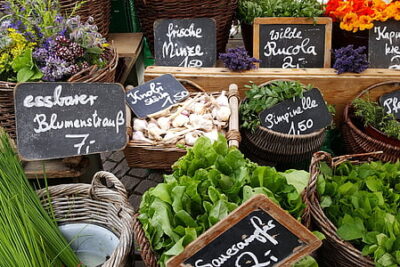
Does the Size of the Pot Affect the Growth of Succulents?

Succulents have become increasingly popular among plant enthusiasts due to their unique and low-maintenance nature. These plants are known for their ability to store water in their leaves, stems, and roots, allowing them to survive in arid environments. However, one aspect that is often debated among succulent growers is the size of the pot and its impact on the growth of these plants.
We will delve into the question of whether the size of the pot affects the growth of succulents. We will explore various factors such as root development, water retention, and nutrient availability that can be influenced by the size of the pot. Additionally, we will discuss the potential advantages and disadvantages of using different pot sizes and provide practical tips for selecting the appropriate pot size for your succulents. Whether you are a seasoned succulent enthusiast or just starting out, this article will provide valuable insights into optimizing the growth and health of your succulent plants through pot selection.
- Yes, larger pots allow for more root growth and can result in larger succulent plants
- Smaller pots can restrict root growth and limit the size of succulents
- The pot size should match the size of the succulent to promote healthy growth
- Choosing the right pot size can prevent overwatering or underwatering of succulents
- Proper drainage is crucial regardless of pot size to prevent root rot in succulents
- A balanced pot size can help maintain the overall aesthetic and balance of a succulent arrangement
- Repotting into a larger pot can be beneficial for succulents that have outgrown their current containers
- Using potting soil specifically formulated for succulents can also promote healthy growth irrespective of pot size
- Regularly monitoring the moisture levels in the potting mix is important for succulent growth, regardless of pot size
- Experimenting with different pot sizes can help determine the optimal size for each individual succulent
- Frequently Asked Questions
Yes, larger pots allow for more root growth and can result in larger succulent plants
When it comes to growing succulents, the size of the pot can play a significant role in their growth and development. While succulents are known for their ability to thrive in various conditions, providing them with a larger pot can offer several advantages.
1. More Room for Root Growth:
One of the primary benefits of using a larger pot for your succulents is that it allows for more room for root growth. Succulents have a unique root system that requires ample space to spread out and establish a strong foundation. When the roots have more space to grow, it promotes healthier and more vigorous plant growth.
2. Enhanced Nutrient Absorption:
 Can You Mix Different Types of Succulents in One Pot?
Can You Mix Different Types of Succulents in One Pot?A larger pot provides more soil volume, which means there is a greater capacity for nutrients to be absorbed by the roots. Succulents, like any other plant, need essential nutrients to thrive. With a larger pot, the soil can hold more nutrients, ensuring that your succulents have access to the necessary elements for optimal growth.
3. Improved Water Retention:
Succulents are known for their ability to store water in their leaves and stems, making them drought-tolerant plants. However, they still require occasional watering. With a larger pot, the soil has a higher water-holding capacity, allowing for better moisture retention. This can help prevent overwatering and create a more balanced and suitable environment for your succulents.
4. Reduced Risk of Root Bound:
When succulents outgrow their pots, their roots can become cramped and bound, leading to stunted growth and potential health issues. By using a larger pot, you provide your succulents with ample space to spread their roots and prevent them from becoming root bound. This ultimately promotes healthier and more robust growth.
While larger pots can be beneficial for the growth of succulents, it is essential to strike a balance. Using a pot that is too large can lead to excessive moisture retention and potential root rot. Therefore, it is crucial to choose a pot that allows for adequate drainage and provides enough room for root growth without being excessively oversized.
If you want your succulents to reach their full potential, consider using larger pots. The increased space for root growth, improved nutrient absorption, enhanced water retention, and reduced risk of root bound will contribute to the overall health and size of your succulent plants.
 DIY Succulent Terrarium: A Step-by-Step Guide to Stunning Home Decor
DIY Succulent Terrarium: A Step-by-Step Guide to Stunning Home DecorSmaller pots can restrict root growth and limit the size of succulents
When it comes to growing succulents, the size of the pot plays a crucial role in their growth and overall health. While succulents are known for their ability to adapt to various environments, providing them with the right pot size is essential for their long-term success.
Smaller pots, although they may seem cute and convenient, can actually hinder the growth of succulents. One of the main reasons for this is that succulents have a unique root system that requires ample space to spread and grow. When confined to a smaller pot, the roots can become cramped and restricted, limiting their ability to absorb nutrients and water from the soil.
Additionally, limited root growth can also lead to stunted growth in succulents. As the roots struggle to expand, the plant's overall development can be affected, resulting in smaller leaves, shorter stems, and a generally compact appearance.
Moreover, smaller pots can also impact the drainage capabilities of the soil. Succulents thrive in well-draining soil, as their roots are susceptible to rotting if they remain in overly moist conditions for extended periods. By providing a larger pot, excess water can easily drain away, preventing waterlogging and potential root rot.
On the other hand, larger pots offer numerous benefits for the growth of succulents. With more room to spread their roots, succulents can establish a stronger and more extensive root system. This enables them to access a greater amount of nutrients and water, promoting healthier and more robust growth.
Furthermore, larger pots provide better stability for the succulents. With a wider base, they are less likely to tip over, especially as the plant grows taller and heavier. This stability is crucial for maintaining the plant's overall balance and preventing any potential damage.
While smaller pots may be visually appealing, they can have a negative impact on the growth and development of succulents. To ensure optimal growth and well-being, it is recommended to provide succulents with larger pots that allow for ample root expansion and better drainage. By doing so, you can create an ideal environment for your succulents to thrive and flourish.
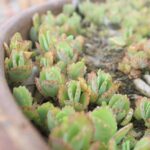 Discover the Best Online Shops for Mini Succulents in Pots
Discover the Best Online Shops for Mini Succulents in PotsThe pot size should match the size of the succulent to promote healthy growth
When it comes to growing succulents, one important factor to consider is the size of the pot. Many succulent enthusiasts wonder whether the size of the pot has any impact on the growth of these beautiful plants. The answer is yes - the pot size can indeed affect the growth of succulents.
Choosing the right pot size is crucial for the overall health and well-being of your succulent. The pot should be proportional to the size of the plant, allowing room for growth while also providing stability and proper drainage.
The Importance of a Properly Sized Pot
Using a pot that is too small for your succulent can hinder its growth. When the roots of a succulent become cramped and restricted by a small pot, it can lead to root rot, stunted growth, and overall poor health. The lack of sufficient space can also limit the plant's ability to absorb nutrients and water.
On the other hand, using a pot that is too large can also be detrimental to your succulent. Excess soil in a larger pot can retain moisture for longer periods, which can lead to overwatering and root rot. Additionally, a large pot may not provide the necessary support for the succulent, causing it to become unstable and potentially topple over.
Choosing the Right Pot Size
To ensure the healthy growth of your succulent, it's important to choose a pot that matches its size. Here are a few guidelines to keep in mind:
- Consider the current size of your succulent: If you have a small succulent, opt for a pot that is 1-2 inches larger in diameter than the plant's width. For larger succulents, choose a pot that allows for 2-3 inches of extra space around the plant.
- Check the drainage holes: Regardless of the pot size, make sure it has sufficient drainage holes at the bottom. This will prevent water from accumulating and causing root rot.
- Consider the growth potential: If your succulent is known to grow rapidly or has a trailing habit, consider choosing a slightly larger pot to accommodate its growth.
Remember, the size of the pot is just one of the factors that contribute to the overall health and growth of your succulent. It's equally important to provide adequate sunlight, water, and well-draining soil to ensure optimal conditions for your plant.
By selecting a properly sized pot, you can provide your succulent with the ideal environment to thrive and showcase its natural beauty.
 Captivating Succulent Beauty: A Photography Journey
Captivating Succulent Beauty: A Photography JourneyChoosing the right pot size can prevent overwatering or underwatering of succulents
When it comes to growing succulents, one of the essential factors to consider is the size of the pot. Many succulent enthusiasts often wonder whether the pot size affects the growth of these plants. The answer is yes, and choosing the right pot size is crucial for the overall health and growth of your succulents.
Preventing overwatering and underwatering
One of the main reasons why pot size matters is because it directly affects the watering needs of succulents. Succulents are known for their ability to store water in their leaves and stems, making them highly adaptable to arid conditions. However, when placed in a pot that is too large, the excess soil can retain moisture for longer periods, leading to overwatering.
On the other hand, if you choose a pot that is too small, it can restrict the growth of the succulent's roots and limit their access to water. This can result in underwatering, causing the plant to become dehydrated and eventually wilt.
In order to prevent overwatering or underwatering, it is important to select a pot size that allows for proper drainage and airflow. A pot with drainage holes at the bottom is essential for excess water to escape, preventing root rot and other water-related issues.
Consider the size of your succulent
 DIY Succulent Terrariums: Simple Steps for Stunning Results
DIY Succulent Terrariums: Simple Steps for Stunning ResultsAnother factor to consider when choosing the right pot size is the size of your succulent. Different succulent species vary in their growth habits and root systems. Some succulents, like Echeverias, have shallow root systems, while others, like Agaves, develop extensive root structures.
If you have a small succulent or a cutting, it is best to select a pot that provides enough room for its roots to grow, without leaving excessive empty space. A pot that is too large can lead to soil moisture imbalance and hinder the succulent's growth.
Choosing the right pot size
So, what is the ideal pot size for succulents? As a general rule of thumb, it is recommended to choose a pot that is about one to two inches larger in diameter than the width of the succulent's current root ball. This allows for some room for growth while still providing a snug fit.
Additionally, consider the depth of the pot. Succulents generally have shallower root systems, so a pot that is too deep can cause the soil to retain excess moisture, increasing the risk of overwatering. Aim for a pot that is deep enough to accommodate the roots comfortably, but not excessively deep.
Conclusion
Choosing the right pot size is essential for the overall health and growth of succulents. By preventing overwatering or underwatering, you can ensure that your succulents thrive in their environment. Consider the size of your succulent and select a pot that allows for proper drainage and airflow. Following these guidelines will help you create an ideal growing environment for your succulents and enjoy their beauty for years to come.
 Moss and Succulents: A Unique Aesthetic for Stunning Décor
Moss and Succulents: A Unique Aesthetic for Stunning DécorProper drainage is crucial regardless of pot size to prevent root rot in succulents
When it comes to growing succulents, one of the key factors to consider is proper drainage. Succulents are known for their ability to store water in their leaves and stems, making them highly adaptable to arid conditions. However, this also means that they are prone to root rot if their roots are constantly sitting in moist soil.
While the size of the pot may not directly affect the growth of succulents, it does have an impact on their overall health and well-being. The most important factor to consider is the drainage capacity of the pot.
A pot with proper drainage holes allows excess water to escape, preventing water from pooling at the bottom. This ensures that the roots of your succulents do not stay wet for prolonged periods, reducing the risk of root rot.
Regardless of the pot size, it is crucial to use a well-draining soil mix specifically formulated for succulents. This type of soil consists of a combination of coarse sand, perlite, and organic matter, which promotes good airflow and prevents water from being retained for too long.
Choosing the right pot size for your succulents
While the size of the pot itself may not directly affect the growth of your succulents, it is essential to choose a pot that is proportionate to the size of your plant. A pot that is too small can restrict the growth of the roots and can lead to stunted growth. On the other hand, a pot that is too large can hold excess moisture, increasing the risk of overwatering and root rot.
Here are some guidelines to help you choose the right pot size:
 Where to Find Bulk Succulent Pots at a Discounted Price
Where to Find Bulk Succulent Pots at a Discounted Price- Choose a pot that is approximately one size larger than the current pot: If you are repotting your succulent, it is generally recommended to select a pot that is slightly larger in diameter than the current one. This allows room for the roots to grow and expand.
- Avoid pots that are too deep: Succulents have shallow root systems, so pots that are too deep may cause the soil to stay moist for longer periods.
- Consider the growth rate of your succulent: Some succulents grow at a faster rate than others. If you have a fast-growing succulent, you may need to choose a slightly larger pot to accommodate its growth.
Remember, the key is to strike a balance between providing enough room for your succulent to grow and ensuring proper drainage to prevent root rot. By paying attention to the pot size and choosing one that promotes good airflow and drainage, you can create an ideal environment for your succulents to thrive.
A balanced pot size can help maintain the overall aesthetic and balance of a succulent arrangement
When it comes to growing succulents, pot size is an important factor to consider. The right pot size can greatly impact the growth and health of your succulents. In this article, we will explore whether or not the size of the pot affects the growth of succulents.
The Importance of Pot Size
Choosing the right pot size is crucial for the overall well-being of your succulents. The size of the pot directly affects various aspects of the plant's growth, including root development, water retention, and overall stability.
Root Development: Succulents have shallow root systems, and they prefer pots that are not too deep. Using a pot that is too large can result in excessive soil moisture, which can lead to root rot. On the other hand, a pot that is too small can restrict the growth of the roots, limiting the plant's ability to acquire nutrients and water.
Water Retention: Succulents are adapted to survive in arid conditions, and they are known for their ability to store water in their leaves and stems. However, if the pot is too large, it can hold excess moisture, causing the soil to stay wet for longer periods. This can lead to overwatering and increase the risk of root rot.
Overall Stability: A balanced pot size is essential to provide stability for your succulents. If the pot is too small, it may not be able to support the weight of the plant, causing it to tip over. Conversely, a pot that is too large can make the plant top-heavy and prone to falling over.
 Enhance Your Garden with Trailing Vine Succulents: A Guide
Enhance Your Garden with Trailing Vine Succulents: A GuideChoosing the Right Pot Size
So, what is the ideal pot size for growing succulents? As a general rule of thumb, it is recommended to choose a pot that is slightly larger than the root ball of your succulent. This allows room for growth while preventing excessive moisture retention.
Consider the Plant's Size: Take into account the mature size of your succulent when selecting a pot. If you have a small succulent, a pot that is 1-2 inches larger in diameter than the current root ball should suffice. For larger succulents, you may need to opt for a pot that is 2-3 inches larger.
Drainage is Key: Regardless of the pot size, ensure it has adequate drainage holes at the bottom. This allows excess water to escape and prevents waterlogged soil. You can also consider using a layer of gravel or perlite at the bottom of the pot to enhance drainage.
Pot size does indeed affect the growth of succulents. Choosing the right pot size is crucial for root development, water retention, and overall stability. By selecting a pot that is slightly larger than the root ball and ensuring proper drainage, you can provide an optimal growth environment for your succulents. Remember, finding the right balance is key to maintaining the overall aesthetic and balance of your succulent arrangement.
Repotting into a larger pot can be beneficial for succulents that have outgrown their current containers
When it comes to caring for succulents, one important consideration is the size of the pot. Many succulent enthusiasts wonder whether repotting into a larger pot will have any effect on the growth and overall health of their plants. Let's explore this topic and see if the size of the pot really does make a difference.
Benefits of repotting into a larger pot
Repotting succulents into a larger pot can offer several benefits for their growth and well-being. Here are a few reasons why you might consider upsizing your succulent's container:
 Discover Unique Succulents in Wood for Stylish Home Decor
Discover Unique Succulents in Wood for Stylish Home Decor- Increased root space: As succulents grow, their roots expand, seeking out more space and nutrients. Moving them into a larger pot provides the roots with room to spread and grow, which can lead to healthier and more vigorous plants.
- Improved drainage: Succulents thrive in well-draining soil, and a larger pot can accommodate a deeper layer of well-draining soil or porous material, ensuring excess water doesn't linger around the roots. This helps prevent issues like root rot and promotes healthier root development.
- Enhanced nutrient uptake: With more soil available in a larger pot, succulents have access to a greater reservoir of nutrients. This can support their overall growth and development, allowing them to reach their full potential.
Considerations when repotting
While repotting into a larger pot can be beneficial, it's important to keep a few things in mind:
- Choose the right size: When selecting a larger pot, aim for one that is about 1-2 inches larger in diameter than the current pot. Going too big too quickly can lead to the soil staying excessively wet, which can be detrimental to succulents.
- Use suitable soil: Opt for a well-draining soil mix specifically formulated for succulents. Avoid heavy, moisture-retentive soils that can cause root rot.
- Watering adjustments: With a larger pot, the soil will take longer to dry out completely. Adjust your watering routine accordingly, allowing the soil to dry out between waterings to prevent overwatering.
Remember, while repotting into a larger pot can be beneficial, it's not always necessary. If your succulent is thriving in its current container and shows no signs of being root-bound, there may not be a need for a bigger pot. Always assess the needs of your succulent on a case-by-case basis.
Repotting succulents into a larger pot can have positive effects on their growth and overall health. It provides more root space, improved drainage, and enhanced nutrient uptake. However, it's important to choose the right pot size, use suitable soil, and adjust watering accordingly. By considering these factors, you can create an optimal environment for your succulents to thrive.
Using potting soil specifically formulated for succulents can also promote healthy growth irrespective of pot size
When it comes to growing succulents, pot size is often a topic of debate among plant enthusiasts. Some believe that a larger pot allows for more root growth and, therefore, better overall growth of the plant. Others argue that succulents prefer smaller pots, as it helps prevent overwatering and promotes better drainage. So, does the size of the pot really affect the growth of succulents?
The answer is not as straightforward as you might think. While the size of the pot can have some impact on succulent growth, it is not the sole determining factor. Other variables, such as the type of potting soil used and the care provided to the plant, also play crucial roles in promoting healthy growth.
The Importance of Using the Right Potting Soil
One of the key factors in promoting healthy succulent growth is using potting soil specifically formulated for these plants. Succulents have unique needs when it comes to soil composition, as they require excellent drainage to prevent root rot.
Using potting soil specifically formulated for succulents is essential, regardless of pot size. This type of soil is typically composed of a mix of materials such as perlite, sand, and peat moss. The perlite and sand help create a well-draining environment, allowing excess water to flow freely away from the roots. Peat moss, on the other hand, helps retain some moisture without causing the roots to become waterlogged.
 Stained Glass-Friendly Succulents: Plants for Decor
Stained Glass-Friendly Succulents: Plants for DecorThe Role of Pot Size in Succulent Growth
While the type of soil used is crucial, the size of the pot can also have some impact on succulent growth. Larger pots allow for more root growth, which can potentially result in a larger and more robust plant. However, it is important to note that succulents prefer to have their roots slightly crowded, as this mimics their natural growing conditions.
When choosing a pot size for your succulents, it is generally recommended to go up one size at a time. For example, if your succulent is currently in a 2-inch pot, you can transplant it into a 4-inch pot. This allows the roots some room to grow without overwhelming them with too much space.
The Importance of Proper Care
Regardless of pot size, providing proper care is crucial for the growth and overall health of succulents. This includes adequate sunlight, appropriate watering, and regular fertilization.
Succulents thrive in bright, indirect sunlight. Placing them near a south-facing window or providing them with filtered sunlight outdoors can ensure they receive the light they need without getting scorched. As for watering, succulents prefer infrequent but deep watering. Allow the soil to dry out completely between waterings to prevent overwatering, which can lead to root rot.
Lastly, fertilizing your succulents can help promote healthy growth. However, be cautious not to over-fertilize, as this can cause burning of the roots. Use a balanced, diluted fertilizer specifically formulated for succulents and follow the instructions on the packaging.
While the size of the pot can have some impact on the growth of succulents, it is not the sole determining factor. Using potting soil specifically formulated for succulents, choosing the right pot size, and providing proper care are all essential for promoting healthy growth and ensuring the longevity of these beautiful plants.
Regularly monitoring the moisture levels in the potting mix is important for succulent growth, regardless of pot size
When it comes to growing succulents, many factors can affect their growth and overall health. One commonly debated factor is the size of the pot. Some believe that a larger pot promotes better growth, while others argue that a smaller pot is more suitable. So, does the size of the pot really affect the growth of succulents?
The answer is not as straightforward as you might think. While pot size can have an impact on succulent growth, it is not the sole determining factor. Other variables, such as watering frequency, sunlight exposure, and soil quality, also play significant roles in a succulent's development.
Why pot size matters
When succulents are placed in a larger pot, they have more room for their roots to spread out and grow. This can lead to increased water absorption and nutrient uptake, which can support healthier and faster growth. However, it's important to note that a larger pot can also hold more moisture, which may increase the risk of overwatering. Overwatering is a common mistake that succulent enthusiasts make, as these plants prefer well-draining soil and can easily suffer from root rot.
On the other hand, smaller pots provide a more confined space for succulent roots. This can limit their growth and prevent them from becoming root-bound. A root-bound succulent occurs when the roots outgrow the pot, causing them to wrap around themselves and potentially restrict nutrient absorption. In such cases, repotting into a larger pot is necessary to allow for continued growth.
The importance of moisture monitoring
Regardless of pot size, regularly monitoring the moisture levels in the potting mix is crucial for succulent growth. Succulents are native to arid environments and have adapted to storing water in their leaves and stems. They are drought-tolerant plants and prefer to be slightly underwatered rather than overwatered. Therefore, it is essential to allow the soil to dry out between waterings to prevent root rot.
One way to determine whether it's time to water your succulent is by checking the moisture level in the potting mix. Stick your finger about an inch into the soil. If it feels dry, it's time to water. If it still feels moist, hold off on watering for a few more days. This method ensures that you are not overwatering your succulent, regardless of the pot size.
While pot size can have an impact on succulent growth, it is not the sole determining factor. Factors like watering frequency, sunlight exposure, and soil quality are equally important. It's crucial to strike a balance between pot size, moisture monitoring, and other care practices to promote optimal succulent growth. Remember, succulents are resilient plants, and with the right care, they can thrive in various pot sizes.
Experimenting with different pot sizes can help determine the optimal size for each individual succulent
When it comes to growing succulents, many factors can affect their growth and overall health. One factor that often gets overlooked is the size of the pot in which they are planted. While it may seem insignificant, the size of the pot can actually have a significant impact on the growth and development of succulents.
Why does pot size matter?
The size of the pot directly affects the root system of the succulent. Succulents have shallow root systems that need proper drainage to thrive. If the pot is too large, it can hold excess moisture, leading to root rot and other issues. On the other hand, if the pot is too small, the roots may become cramped, hindering their growth and potentially stunting the plant's overall development.
Choosing the right pot size
When selecting a pot for your succulent, it's essential to consider the size of the plant and its growth habits. Here are some guidelines to help you choose the right pot size:
- For young succulents: When starting with small succulents, it's best to opt for a small pot with a diameter of around 2-4 inches. This size allows for proper root development without overwhelming the plant.
- For mature succulents: As succulents grow, they may outgrow their initial pot. It's crucial to repot them into a slightly larger pot to accommodate their expanding root system. A pot with a diameter of 4-6 inches is usually sufficient for most mature succulents.
- Consider the growth habits: Some succulents, such as rosette-shaped varieties, have a spreading growth habit. For these types, opt for wider pots to allow sufficient space for the plant to grow and spread. Other succulents, like columnar or trailing varieties, may benefit from taller pots to accommodate their vertical growth.
Experimenting with different pot sizes
Every succulent is unique, and what works for one may not work for another. If you're unsure about the optimal pot size for a specific succulent, don't be afraid to experiment. You can try planting multiple specimens in pots of different sizes and monitor their growth over time.
Keep in mind that succulents thrive in well-draining soil, so ensure that your pots have drainage holes to prevent water from pooling at the bottom. Additionally, avoid overwatering your succulents, as this can lead to root rot and other issues, regardless of the pot size.
Final thoughts
The size of the pot plays a crucial role in the growth and development of succulents. By choosing the right pot size and providing proper drainage, you can create an ideal environment for your succulents to thrive. Remember to observe and experiment with different pot sizes to find what works best for each individual plant. With the right care and attention, your succulents will flourish and bring beauty to any space.
Frequently Asked Questions
1. Does the size of the pot affect the growth of succulents?
Yes, the size of the pot can impact the growth of succulents. A larger pot allows for more root growth and can support a larger plant, while a smaller pot may restrict root growth and limit the size of the plant.
2. How often should I water my succulents?
Succulents generally require less water compared to other plants. It is best to water them when the soil is completely dry, which can be around every 1-2 weeks depending on the specific succulent and environmental conditions.
3. Can I grow succulents indoors?
Yes, succulents can be grown indoors as long as they receive adequate sunlight. Place them near a sunny window or use grow lights to provide the necessary light for their growth.
4. Do succulents need fertilizer?
Succulents are low-maintenance plants and can thrive without regular fertilization. However, a diluted, balanced fertilizer can be applied during the growing season to promote healthier growth. It is important to follow the instructions and not over-fertilize, as this can harm the plants.
If you want to read more articles similar to Does the Size of the Pot Affect the Growth of Succulents?, you can visit the Planters and Arrangements category.

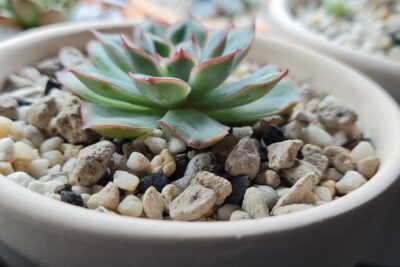


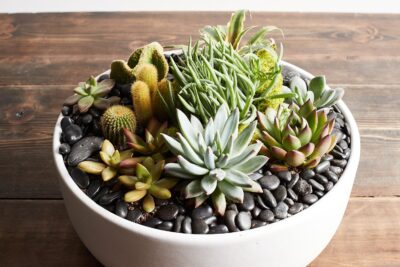
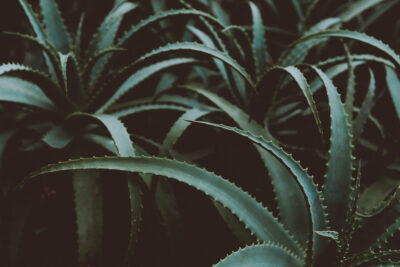
You Must Read